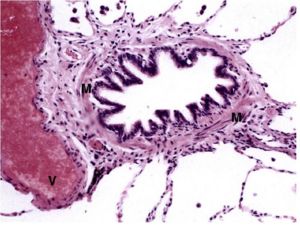Bronquios y Bronquiolos - Anatomía & Fisiología
Introducción
The trachea bifurcates at the levels of the 4th-6th intercostal space, approximately halfway between the thoracic inlet and the diaphragm. It divides into two principle bronchi, tubes which conduct air into the lungs, and they divide into two lobar bronchi for the left lung, and into four lobar bronchi for the right lung. These further divide into smaller bronchi and bronchioles within the lung tissue. La tráquea se bifurca a nivel del sexto espacio intercostal-4, aproximadamente a medio camino entre la entrada del tórax y el diafragma . Se divide en dos bronquios principio , los tubos que conducen el aire hacia los pulmones, y se divide en dos bronquios lobulares para el pulmón izquierdo, y en los bronquios lobares cuatro para el pulmón derecho. Estos se dividen en otras más pequeñas aún más los bronquios y los bronquiolos en el tejido pulmonar.
Estructura
The structure of the larger bronchi is identical to that of the trachea. On the smaller bronchi the C-shaped cartilage rings are gradually replaced by irregular plaques of cartilage. Bronchioles have no cartilage at all. The bronchioles are less than 1mm in diameter, and undergo further divisions, the last of which is characterised by the loss of goblet cells. La estructura de los bronquios más grandes es idéntica a la de la tráquea . En los bronquios más pequeños anillos de cartílago en forma de C son reemplazados gradualmente por irregulares placas de cartílago. Bronquiolos no tienen cartílago en absoluto. Los bronquiolos son menos de 1 mm de diámetro, y se someten a más divisiones, la última de las cuales se caracteriza por la pérdida de células caliciformes.
Función
The bronchi and bronchioles are parts of the 'Conduction Zone' of the respiratory system - allowing the passage of air from the external environment into the lungs where gaseous exchange can take place. The conduction zone is also known as dead space, and no gaseous exchange can take place in this area. Some of the Bronchioles have alveoli scattered along their length, and thus form part of the 'Respiratory Zone' - the site for gaseous exchange. Los bronquios y los bronquiolos son parte de la " Zona de conducción " del sistema respiratorio - que permite el paso del aire del ambiente exterior a los pulmones donde el intercambio gaseoso puede tener lugar. La zona de conducción también se conoce como espacio muerto , y no hay intercambio gaseoso puede tener lugar en este ámbito. Algunos de los bronquiolos tienen alvéolos dispersos a lo largo de su longitud, y por lo tanto forma parte de la " zona respiratoria ' - el sitio para el intercambio gaseoso.
Species Differences
Between species the diameter of the bronchi and bronchioles vary greatly and more significantly than the variations of the trachea. The number of bronchial divisions before bronchioles are present varies by species - small mammals such as mice may have only 4/5 generations, whereas 12+ may be necessary in larger animals. Avian respiration is very different to that of mammals. The respiratory systems of non-homeotherms are also very different to that of mammals.
Histology
The histology of the bronchi is almost identical to that of the trachea. The lumen of the bronchus is lined by a pseudostratified epithelium, including goblet cells and serous cells. Beneath the narrow layer of connective tissue under the epithelium lie well-developed spiral bands of smooth muscle.
The Bronchioles have no cartilage rings but have well developed muscular walls to enclose the lumen. The epithelium is reduced to cuboidal, and in the normal animal it contains no mucus secreting glands. There are many lymphoid nodules beneath the epithelial layer.
The respiratory bronchioles have few alveoli scattered along the length, at the entrance of which is simple squamous epithelium, and bronchial smooth muscle bundles.
Enlaces
Click here for information on pathology of bronchi and bronchioles
Referencias
Dyce, K.M., Sack, W.O. and Wensing, C.J.G. (2002) Textbook of Veterinary Anatomy. 3rd ed. Philadelphia: Saunders.
Budras, K.D., McCarthy, P.H., Fricke, W. and Richter, R. (2002) Anatomy of the Dog. 4th ed. Hannover: Schlutersche GmbH & Co. KG, Verlag und Druckerei.
